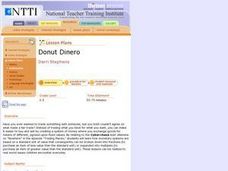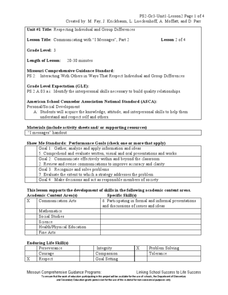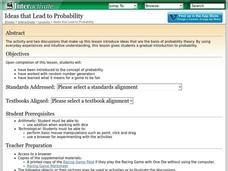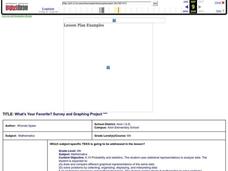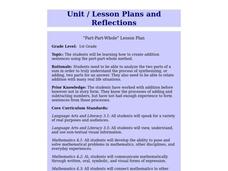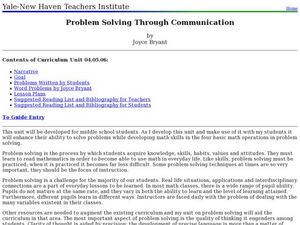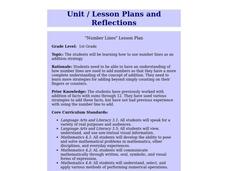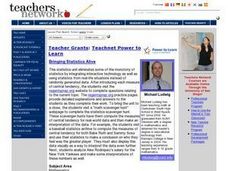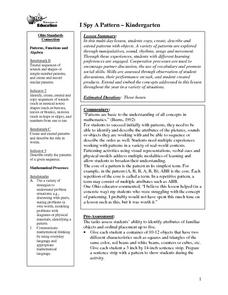Curated OER
Water Treatment Plant Tour
Students define vocabulary related to geometry and calculate the volume. In this geometry lesson, students calculate flow rates, and volume as it relates to a water plant facility. They calculate the volume of three dimensional shapes...
Curated OER
Equivalent Fractions
Students complete a worksheet. In this fractions lesson, students review their knowledge of fractions, define equivalent fractions, see examples of equivalent fractions and practice making equivalent fractions.
Curated OER
Killer Wrapper
Learners examine the importance of food safety and the impact it has on their lives. In this health lesson students complete an oral report on food poisoning and design a low cost "safe" packing material for bread.
Curated OER
Are We Couch Potatoes or Busy Bees? Data Analysis of Physical Activity in School
Learners study practical data analysis within the constraints of the scientific method. In this data activity students collect and enter data into a computer spreadsheet then create graphs.
Curated OER
Donut Dinero
Students set up a classroom currency exchange and explore the idea of bartering to get what they want. They create a monetary unit that is based on fractions and multiples of a standard unit, and compare this system to the U.S. monetary...
Curated OER
Communicating with "I Messages", Part 2
Third graders listen to ways they share their feelings with others. After brainstorming situations where "I messages" would be appropriate, pairs of students write messages from the lists they developed. They discuss how their messages...
Curated OER
Ideas that Lead to Probability
Young scholars explore the concept of probability. In this probability lesson plan, students use random number generators to determine probabilities of events. Young scholars discuss if certain probable events are fair. Students...
Curated OER
Subtract Positive and Negative Integers
Review the concept of subtracting positive and negative integers. Learners review the rules for subtracting integers, use manipulatives to visualize the process, and complete an assessment.
Curated OER
Reading the River - Biological Classification
Youngsters create a list of grocery store items and then work together to categorize them as if they were setting up the shelves of the market. Then they are given a box of miscellaneous objects to practice categorizing. With these two...
Curated OER
Late-In-The-Year Counting
Students practice forward and backward counting. For this counting lesson, students calculate how many objects in a bag by counting forward and then count backward to check.
Curated OER
What's Your Favorite? Survey And Graphing Project
Sixth graders create and edit spreadsheet documents using all data types, formulas and functions, and chart information. They collect and organize data that be portrayed in a graph that they create using EXCEL.
Curated OER
What's Cooking - A Colonial Recipe
Eleventh graders explore Colonial and modern techniques, vocabulary, and ingredients of cooking and recipes. They gain understanding of the challenges of cooking in colonial times and modern adaptations.
Curated OER
Will There be Enough Water?
Students investigate water usage, water available, and water demand historically in the local area. They use projections of water usage, availability and demand up to the year 2050. Students use graphs to relate as well as compare and...
Curated OER
Part-Part-Whole
First graders work with partners, using cubes to make addition sentences. In this math lesson, 1st graders separate cubes into 2 parts and discuss the relationship to addition sentences. Students practice separating cubes. Students make...
Curated OER
Double Serving Lesson Plan
First graders add doubles numbers in number sentences. In this doubles numbers lesson plan, 1st graders list things that come in pairs, create doubles addition sentences, and solve riddles with doubles.
Curated OER
Part Part Whole
First graders solve number sentences. For this problem solving lesson, 1st graders construct addition sentences using a part part whole mat. Students demonstrate problem solving strategies using cubes.
Curated OER
Mapping with a Compass: A Simulated Survey
Students use compasses and grids to map the locations of artifacts found in a simulated dig site. In groups, they role-play as future archeologists excavating a school site. Groups begin at their assigned datum and site the artifacts...
Curated OER
Problem Solving Through Communication
Students discuss effective ways to solve and communicate problems. In this word problem lesson, students solve a variety of word problems written by varying authors. They rewrite words using algebraic terminology.
Curated OER
Coordinate Grid: Mapping Archeological Sites
Fourth graders discover how to apply the Cartesian coordinate system by figuring out the length and width of their school playground. They determine that pacing is an important tool for the initial mapping of a site. Students conduct a...
Curated OER
Number Lines
First graders examine the number line as an addition strategy. In this math lesson plan, 1st graders create a number line and use it to help them solve addition problems.
Curated OER
Location, Location, Location: Using a Grid to Determine Context
Seventh graders are introduced to making inferences about artifacts. Using a grid system, they locate the artifacts and determine where they originated from. They use this information to make conclusions about the way people lived...
Curated OER
Bringing Statistics Alive
Learners compute mean, median and mode and compare mean, median and mode to a real-world application to identify their practical uses. They apply mean, median and mode to real-world statistical data. Finally, students organize data into...
Curated OER
Multiplication Word Problems Using Different Representations
Students solve multiplication word problems by using base 10 blocks and drawing pictures. In this multiplication lesson plan, students also write a reflection of their work.
Curated OER
I Spy a Pattern-Kindergarten
Students copy, create, describe, and extend patterns with objects. They explore a variety of patterns through the use of manipulatives, sound, rhythms, songs and movement. Cooperative processes are used to encourage partner discussion.
Other popular searches
- Everyday Mathematics Arrays
- Everyday Mathematics Review
- Everyday Mathematics Mixed
- Everyday Mathematics Dominos
- Everyday Mathematics Page 38






